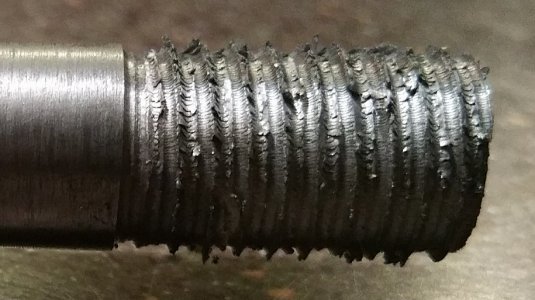- Joined
- Feb 15, 2015
- Messages
- 27
Hey guys,
I did my first threading a couple days ago on some aluminum. It turned out great. Fit nice.
Fast forward to today. I was going to make my first useful part that I've been wanting for my belt grinder. I did not have anything very machinable in the size that I needed so I grabbed whatever I had in the right size. This happened to be D2 tool steel.
I turned part of it down to 1/2" like I wanted. I started threading the end of it and man...something just wasn't going right. Can anybody tell what I did wrong just by looking at it? It looks like it just ripped it apart. I think I did miss a bit on the last engagement of the half nut, but regardless.....
This was supposed to be 1/2" 13 TPI
Zoomed in for your viewing pleasure

I did my first threading a couple days ago on some aluminum. It turned out great. Fit nice.
Fast forward to today. I was going to make my first useful part that I've been wanting for my belt grinder. I did not have anything very machinable in the size that I needed so I grabbed whatever I had in the right size. This happened to be D2 tool steel.
I turned part of it down to 1/2" like I wanted. I started threading the end of it and man...something just wasn't going right. Can anybody tell what I did wrong just by looking at it? It looks like it just ripped it apart. I think I did miss a bit on the last engagement of the half nut, but regardless.....
This was supposed to be 1/2" 13 TPI
Zoomed in for your viewing pleasure

